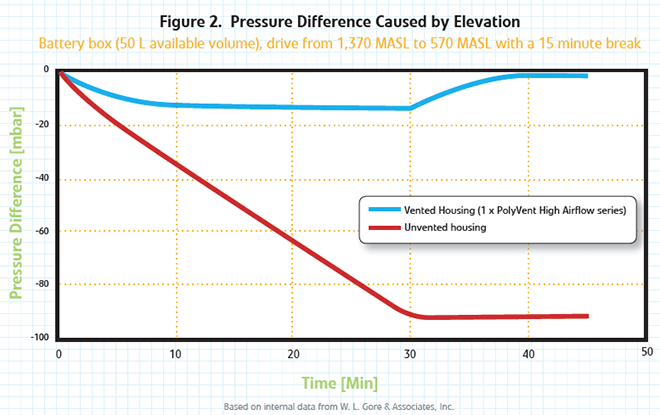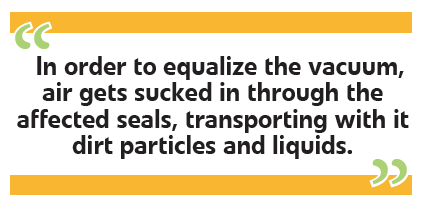Protecting a car’s sensitive electronics throughout its lifetime is a must, whether it’s a conventional ICE vehicle or an EV. However, the larger electronics in plug-in vehicles have more power, more heat and higher pressure differentials that present new technological challenges to OEMs and suppliers.
Any power semiconductor inevitably generates heat while conducting current, due to small inefficiencies in the device. Because the electronics in hybrids and EVs operate at high power levels, the heat created can be substantial. To protect the electronics from damage and maintain optimal efficiencies, they are usually cooled with fluids. Robert Lavertu, Product Specialist at W. L. Gore & Associates, told Charged that abrupt changes in temperature can cause pressure differentials which, if not managed, can lead to premature failure of the electronics.

“One challenge for electronic components both in cars with internal combustion engines and in those with hybrid or electric motors is the difference between their operating temperature and the cooler outside environment,” said Lavertu. “After heating up in operation, components can cool off very rapidly if they encounter cold spray from the road or at the carwash. This subjects the electronics housings to an extreme vacuum, which consequently pulls air in through the seals. Over time, this adverse pressure equalization stresses the seals and sealing components so much that dirt particles and liquids can get in and corrode the electronics, shortening their service life. The fact that low-viscosity fluids and cleaning agents are used in vehicles only heightens the danger of ingress.”
According to Lavertu – who specializes in membrane technology – venting enclosures is critical to ensuring that weathertight seals last the lifetime of a vehicle.
Equalizing Inverter Pressure
To demonstrate this phenomenon, Lavertu presented the example of an AC inverter splashed with chilled water. The basis for the calculation is a housing measuring 40x20x20 cm, which corresponds to a volume of 16 L. In this example, one quarter of the housing’s interior is empty, which means that the housing contains 4 L of free air volume. While in operation, the inverter reaches a temperature of 70 degrees C. When the underside of the car is sprayed with cold water, 8-10 degrees C, it causes the inverter to cool down to 40 degrees C within a five-minute period.
“In an unvented housing, this temperature differential leads to a vacuum of about 90 mbar,” said Lavertu. “This vacuum occurs every time the car is driven through cool water, and stresses the seals so much that they can begin to leak over time. The result is that cleaning agents, oil, chemicals, water, etc. get into the inverter housing and can damage the sensitive electronics.”
Lavertu says that adding a vent ensures the vacuum is rapidly equalized and that pressure spikes cannot occur at all (Figure 1). And after only six minutes, the pressure inside the vented housing returns to the ambient pressure.

The Battery Box
Because of its size, Lavertu notes that the high-voltage battery of a hybrid or electric vehicle will need a venting solution that achieves much higher airflow to equalize pressure. To illustrate one problematic pressure scenario, he describes a high-altitude 30-minute drive in Austria from Innsbruck (570 m above sea level) to the Brenner Pass (1,370 m above sea level).
An EV with a battery housing measuring 100x50x30 cm will have a volume of 150 L and a free air volume of approximately 50 L. “In an elevation difference of 800 m, that unvented battery enclosure will cause a positive pressure of 90 mbar to build up,” said Lavertu. “Even with a 15-minute break at the pass’s rest stop, the pressure cannot equalize, which puts permanent stress on the seals. 90 mbar positive pressure corresponds to approximately 450 kg acting on the surface area of 0.5 m². A lightweight housing cannot withstand such pressure for long. And although the seals are designed to cope with high loads, this extreme stress will eventually cause them to fail, and the housing will no longer be sealed properly.”
Since the battery comes into contact only with water spray and not with water at high pressure, the IP protective rating does not need to be as high as it does for components built into the engine compartment, explained Lavertu.
“Even more dangerous than the positive pressure from the trip up the mountain is the vacuum of 90 mbar that develops in the housing during the drive back down.” Lavertu continued. “In order to equalize the vacuum, air gets sucked in through the affected seals, transporting with it dirt particles and liquids; these could condense in the housing and cause damage. In a vented battery housing, only a negligible vacuum of about 15 mbar develops (Figure 2). This does not overtax the seals and can be completely equalized during a 15-minute break.”

Membrane tech
To achieve pressure equalization and ensure reliability of the power electronics and the high-voltage battery pack throughout the car’s service life, Lavertu recommends using venting solutions that feature membranes. Membrane technology permits air exchange in a closed housing while simultaneously keeping out liquids and dirt particles. As seen in the example of a high-voltage battery box, airflow rate and water entry pressure are the two fundamental characteristics that determine the membrane’s performance for a particular application. Airflow describes how much air passes through the membrane in a given period, at a given differential pressure. This determines how quickly pressure differentials can be equalized. Water entry pressure is the minimum hydrostatic pressure that the membrane must be able to withstand before it leaks. But airflow and water entry pressure are not the only variables, explained Lavertu. “Temperature resistance and chemical resistance are also important parameters for membrane venting components.”

Large battery housings, for instance, which need to let lots of air in and out quickly but have a less demanding IP protection rating, should be fitted with a membrane that permits higher airflow. Electronics housings fitted under the hood, on the other hand, often have to cope with high temperature peaks. The minimum required IP protective rating is IP6k9k, which ensures that electronics housings are reliably protected from dust particles, brief submersion and vapor stream. These generally feature membranes with high temperature resistance.
Since the challenges associated with individual applications vary widely, automotive OEMs and suppliers should, in each case, work closely together with the membrane manufacturer to develop a technically and economically suitable solution.
This article originally appeared in Charged Issue 14 – June/July 2014





















































